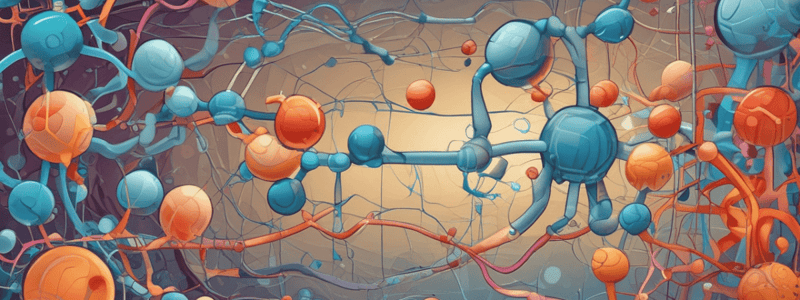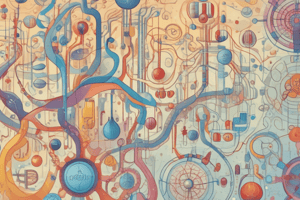Podcast
Questions and Answers
What is the primary function of the Warburg effect in cancer cells?
What is the primary function of the Warburg effect in cancer cells?
- To enhance glucose uptake and glycolysis (correct)
- To increase oxygen consumption
- To reduce ATP production
- To activate apoptosis
Why is the Warburg effect being studied intensively?
Why is the Warburg effect being studied intensively?
- Because it is a unique feature of normal cells
- Because it is a ubiquitous characteristic of all cell types
- Because of its potential as a diagnostic tool and/or therapeutic target (correct)
- Because it is a newly discovered phenomenon
What is the end product of glycolysis under aerobic conditions?
What is the end product of glycolysis under aerobic conditions?
- Carbon dioxide
- Pyruvate (correct)
- Acetyl CoA
- Lactate
Which of the following cell types is NOT highly dependent on glycolysis?
Which of the following cell types is NOT highly dependent on glycolysis?
What is the net ATP yield from complete oxidation of one glucose molecule in aerobic conditions?
What is the net ATP yield from complete oxidation of one glucose molecule in aerobic conditions?
Which enzyme is responsible for the phosphorylation of glucose in the first step of glycolysis?
Which enzyme is responsible for the phosphorylation of glucose in the first step of glycolysis?
Which of the following is NOT a product of glycolysis?
Which of the following is NOT a product of glycolysis?
How many ATP molecules are produced through substrate-level phosphorylation in glycolysis?
How many ATP molecules are produced through substrate-level phosphorylation in glycolysis?
What is the primary function of lactate dehydrogenase in muscle?
What is the primary function of lactate dehydrogenase in muscle?
Which of the following statements is true about substrate-level phosphorylation?
Which of the following statements is true about substrate-level phosphorylation?
What is the end product of glycolysis under aerobic conditions?
What is the end product of glycolysis under aerobic conditions?
What is the role of NAD+ in glycolysis?
What is the role of NAD+ in glycolysis?
Which of the following tissues relies heavily on glycolysis for energy production?
Which of the following tissues relies heavily on glycolysis for energy production?
What is the purpose of glycolysis regulation?
What is the purpose of glycolysis regulation?
What is the net yield of ATP from glycolysis?
What is the net yield of ATP from glycolysis?
What is the primary function of glycolysis in the brain?
What is the primary function of glycolysis in the brain?
Which enzyme is inhibited by ATP through allosteric regulation?
Which enzyme is inhibited by ATP through allosteric regulation?
What is the fate of pyruvate in anaerobic glycolysis?
What is the fate of pyruvate in anaerobic glycolysis?
Which of the following is NOT a source of glucose for glycolysis?
Which of the following is NOT a source of glucose for glycolysis?
What is the primary function of glycolysis in red blood cells?
What is the primary function of glycolysis in red blood cells?
Which enzyme catalyzes the conversion of pyruvate to lactate?
Which enzyme catalyzes the conversion of pyruvate to lactate?
What is the Warburg effect?
What is the Warburg effect?
Which of the following is a characteristic of glycolysis?
Which of the following is a characteristic of glycolysis?
What is the fate of glyceraldehyde-3-phosphate in glycolysis?
What is the fate of glyceraldehyde-3-phosphate in glycolysis?
Flashcards are hidden until you start studying
Study Notes
Anaerobic Metabolism: Glycolysis
- Anaerobic metabolism is the conversion of glucose to pyruvate in the glycolysis pathway
- The glycolysis pathway occurs in the cytosol and involves 10 soluble enzymes
- The pathway is present in all tissues and has multiple functions, including energy trapping (ATP synthesis), and providing intermediates for fat and amino acid synthesis
Structure and Function of Glucose and Glycogen
- Glucose is a monosaccharide that is an immediate energy source for glycolysis
- Glycogen is a polysaccharide that serves as a medium-term fuel source
- Glycogen is stored in tissue stores and has low osmolarity
- Glucose can be synthesized from non-carbohydrate sources through gluconeogenesis
Glycolysis: Key Points
- Glycolysis is the conversion of glucose to pyruvate
- The pathway occurs in the cytosol and involves 10 soluble enzymes
- The pathway has multiple functions, including energy trapping (ATP synthesis), and providing intermediates for fat and amino acid synthesis
- Glycolysis is a key pathway for ATP production in all tissues
Sources of Glucose for Glycolysis
- Glucose can be obtained from dietary sugars and starch
- Glucose can be broken down from stored glycogen in the liver
- Glucose can be recycled from lactic acid, amino acids, or glycerol
Summary Diagram of the Glycolysis Pathway
- The glycolysis pathway can be divided into 4 stages: activation, splitting, oxidation, and ATP synthesis
- The pathway involves 10 reactions, with key enzymes and intermediates including hexokinase, phosphofructokinase, aldolase, and pyruvate kinase
Activation Stage of Glycolysis
- The activation stage involves the conversion of glucose to fructose 1,6-bisphosphate
- The stage requires the use of 2 ATP molecules
- Key enzymes involved in this stage include hexokinase, phosphohexose isomerase, and phosphofructokinase
Splitting Stage of Glycolysis
- The splitting stage involves the conversion of fructose 1,6-bisphosphate to glyceraldehyde 3-phosphate and dihydroxyacetone phosphate
- The stage involves the action of the enzyme aldolase
- The stage results in the splitting of the 6-carbon sugar into two 3-carbon units
Oxidation Stage of Glycolysis
- The oxidation stage involves the conversion of glyceraldehyde 3-phosphate to 1,3-bisphosphoglycerate
- The stage involves the action of the enzyme glyceraldehyde 3-phosphate dehydrogenase
- The stage results in the removal of 2H atoms and the production of NADH
ATP Synthesis Stage of Glycolysis
- The ATP synthesis stage involves the conversion of 1,3-bisphosphoglycerate to pyruvate
- The stage involves the action of the enzymes phosphoglycerate kinase, phosphoglycerate mutase, and enolase
- The stage results in the synthesis of 2 ATP molecules
Yields of ATP from Glycolysis
- The net yield of ATP from glycolysis is 2 ATP molecules
- However, the pathway can yield 4 ATP molecules in the later stages, resulting in a net gain of 2 ATP molecules
- Further ATP molecules can be produced through mitochondrial metabolism
Anaerobic Glycolysis
- Anaerobic glycolysis occurs in the absence of oxygen
- In anaerobic glycolysis, pyruvate is converted to lactate in order to regenerate NAD+
- The reaction is catalyzed by lactate dehydrogenase
Regulation of Glycolysis
- The glycolysis pathway is regulated by allosteric control and hormonal control
- One example of allosteric control is the inhibition of phosphofructokinase by ATP
Specialised Functions in Tissues
- In skeletal muscle, glycolysis provides ATP for intense exercise
- In red blood cells, glycolysis is the only pathway for ATP production
- In the brain, glycolysis is a major source of ATP
Warburg Effect
- The Warburg effect is the phenomenon of tumour cells preferring anaerobic glycolysis, even in the presence of oxygen
- The effect is named after Otto Warburg, who first described it over 90 years ago
Studying That Suits You
Use AI to generate personalized quizzes and flashcards to suit your learning preferences.




